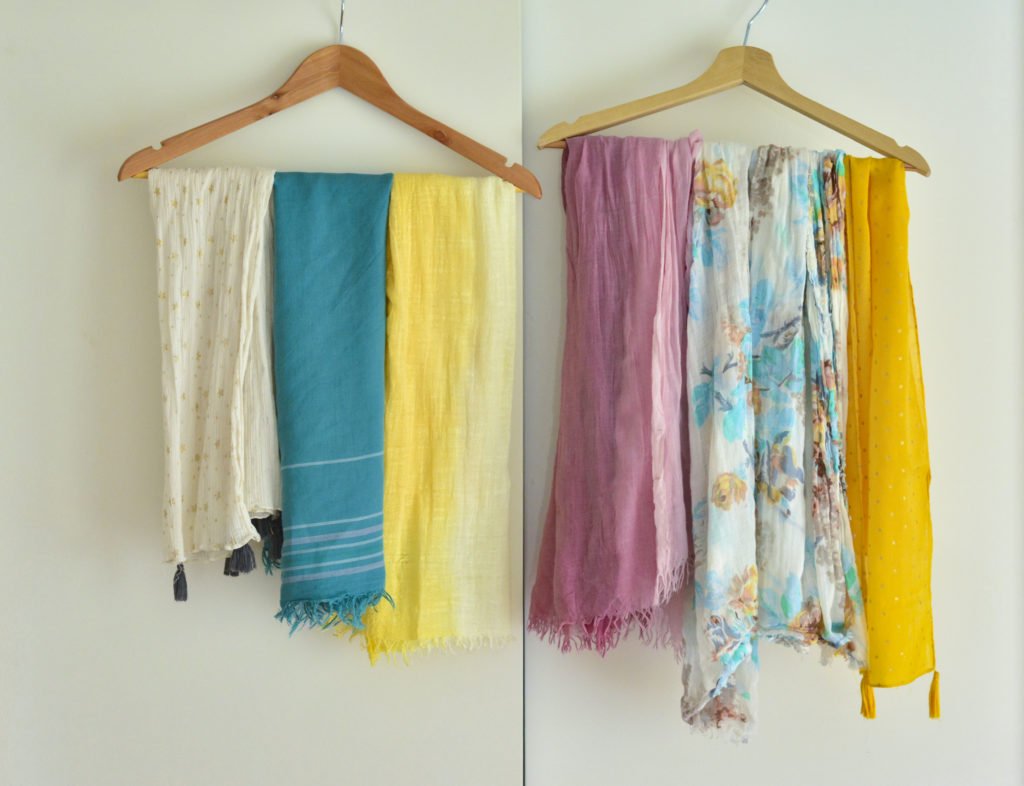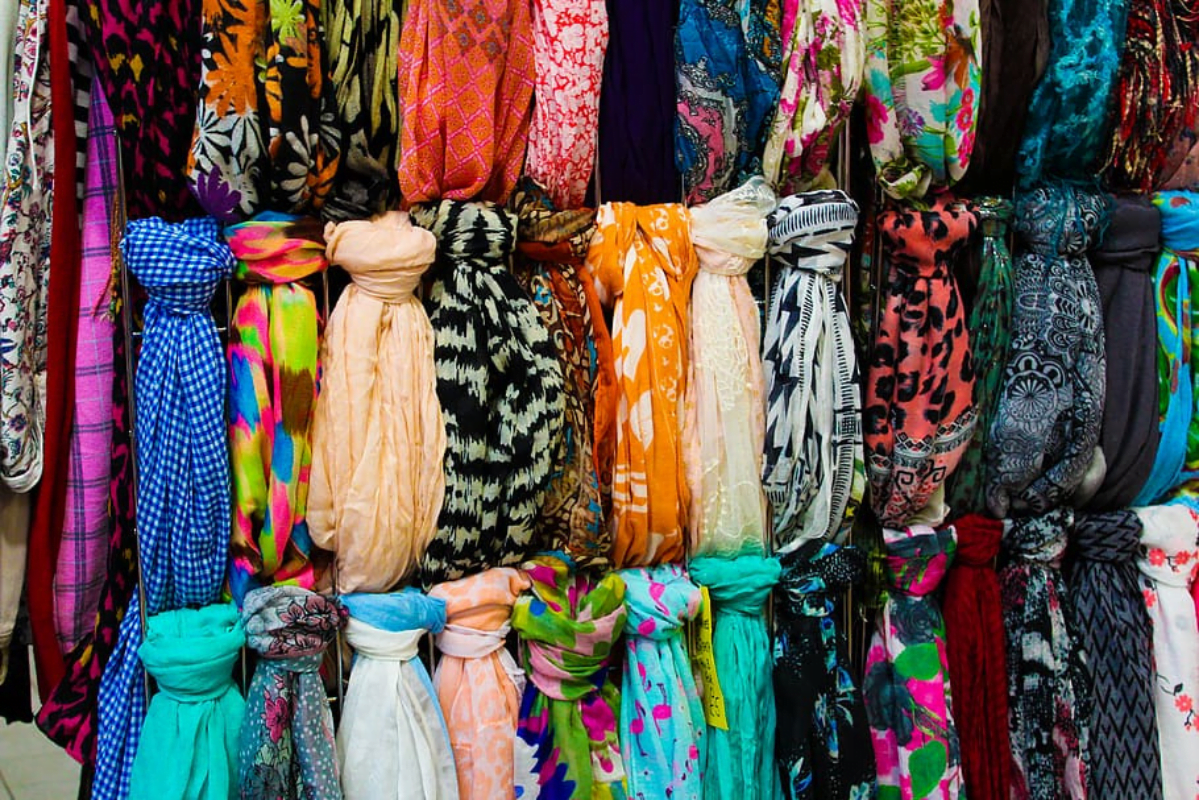Scarves are practical accessories and can be beautiful art pieces when displayed on a wall. Hanging scarves on the wall can transform them into unique decor items that showcase your style and taste.
In this article, we’ll explore the pros and cons of hanging scarves on the wall, delve into the top five methods, and address frequently asked questions about hanging scarves on the wall.
How to Choose the Right Method for My Scarves?

Selecting the proper method to hang your scarves on the wall is essential in showcasing your collection to its fullest potential. Various factors, such as the material and weight of the scarves, your style, your budget, and the overall decor, will influence your choice.
Whether you want to create a stunning visual centerpiece or a more subdued and elegant presentation, understanding your scarves’ unique characteristics and requirements will guide you toward the most fitting display method.
Top 5 Methods and Ideas to Hang Scarves on the Wall
Each method offers a unique way to display scarves, allowing for personalization and creativity in your living space. Understanding the pros and cons allows you to choose the plan that best suits your scarves, style, and home.
Let’s drape ourselves in creativity and unfurl the top 5 methods to hang those scarves:
Using Decorative Hooks
Decorative hooks are ornamental pieces that can be affixed to the wall regularly. They can vary in design and material, from sleek metal to rustic wooden hooks. Scarves can be looped, draped, or tied over these hooks, offering an easily accessible and visually pleasing display.
This method allows for creativity in how the scarves are presented. Whether grouped by color, pattern, or size, the hooks provide flexibility in creating a display that fits your style. Regular maintenance is minimal, and changing the arrangement is simple.
Pros
- Easy to install; no specialized tools required.
- Visually appealing: the decorative hooks themselves add to the room’s decor.
Cons
- Limited weight capacity; may not support heavy or numerous scarves on one hook.
- Placement requires careful consideration to avoid an overcrowded look.
Frame Them in Shadow Boxes
Shadow boxes are enclosed display cases that provide depth, allowing the scarves to be viewed as three-dimensional art pieces. They can be customized to fit different scarf sizes and may include UV-protective glass to prevent fading.
This method is ideal for showcasing individual scarves or smaller collections. By framing scarves in shadow boxes, you preserve them behind glass, protecting them from dust and potential damage while offering a more formal presentation.
Pros
- Preserves the scarf; protection against environmental factors.
- It adds a formal, elegant touch to the room.
Cons
- It can be expensive; custom shadow boxes and professional framing add up.
- Less flexibility; changing the display requires effort.
Utilize a Curtain Rod
A curtain rod can be installed on a wall, and scarves can be draped or hung with rings in a cascading manner. The rod can be simple or decorative, depending on your desired aesthetic.
This method mimics the way curtains hang, allowing scarves to flow naturally. Dropping them over a rod will enable scarves to be easily changed, rearranged, or layered. It’s a method that showcases the full beauty of each scarf while remaining functional.
Pros
- Easy to change and arrange; swap scarves as you wish.
- Inexpensive; curtain rods and rings are readily available.
Cons
- It may require additional wall support, securing the rod for heavier scarves.
- Limited to certain scarf lengths; very short or long scarves might not display well.
Use Clip Hangers
Clip hangers are designed to grasp the scarf without piercing the fabric. They can be hung on a rod, a wire, or directly on hooks on the wall. This method is gentle and doesn’t cause damage to the scarf.
Using clip hangers, scarves can be displayed horizontally or vertically, offering various design possibilities. It’s an accessible option for creativity and easy rearrangement, providing a casual yet organized look.
Pros
- Gentle on the scarf; it doesn’t cause holes or creases.
- Flexible display options; easy to change the layout.
Cons
- Clips may become loose over time; may require replacement.
- May not hold heavier scarves; limited weight capacity.
Create a Scarf Collage

Creating a scarf collage involves arranging scarves on the wall in a particular pattern or design and securing them with suitable adhesive or pins. It can be a mixture of shapes, colors, and textures, forming a visually engaging piece of wall art.
This method requires careful planning, but the result can be a stunning and personalized art display. Whether you choose a symmetrical pattern or an abstract arrangement, a scarf collage allows endless creativity. A background panel or fabric might help with alignment and attachment.
Pros
- Visually striking; it creates a one-of-a-kind artwork.
- Allows creativity; mixing, and matching for unique designs.
Cons
- It may damage the scarves if not done correctly; choosing the right adhesive or pins is crucial.
- Requires careful planning and potentially professional assistance; alignment and secure attachment are critical.
Frequently Asked Questions
Yes, by using methods like shadow boxes or gentle clip hangers.
The cost can vary depending on the method chosen, with options to suit various budgets.
Methods like decorative hooks and curtain rods allow for easy changes.
Protecting scarves from direct sunlight and using UV-protective frames can prevent fading.





